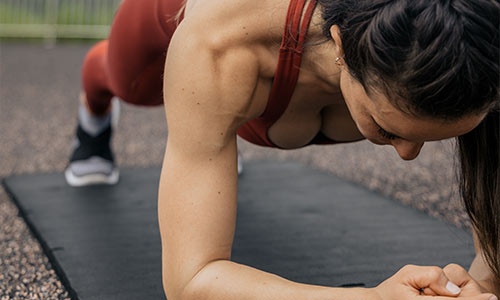The Ultimate Guide to Running Faster: 5 Pro Tips
Author

Chris shares his passion for cycling, hiking, skiing, and climbing from Buxton, in the Peak District. As a blogger for Outdoor Look, Chris shares outdoor tips and indoor tricks to help you get the most out of your time spent outside. When he's not out adventuring he's making videos or trying to keep up with his 4-year-old son.
Running is a great way to get in shape, clear your head, and explore your surroundings. But sometimes, running can feel like a slog. For anyone who has ever run a race, whether it’s a 100-metre sprint or a full marathon, the question of how to run faster always arises. While there’s no magic answer that will turn you into the world’s fastest runner overnight, there are definitely some things you can do to pick up your speed and improve your running performance.
In this blog post, we’ll go over some of the ways you can start running faster, from improving your technique to adding speed workouts to your training regimen. These will help you pick up the pace and make running feel easier and even more enjoyable. Let’s begin.
1: Strengthen your core
Having strong abdominal and lower-back muscles will help you run faster by improving your form and preventing injury. Unfortunately, many runners don't focus on building core strength, thinking that they'll just naturally get stronger as they run more miles. But if you want to see results both in terms of speed and in terms of avoiding injuries, it's important to focus on building core strength from the very beginning.
The good news is that there are plenty of ways to do this, even if you're not a fan of crunches or sit-ups. Planks, bird dogs, and deadbugs are all great exercises for runners who want to build core strength.

2: Develop a better running technique
One of the best ways to start running faster is by improving your technique. Good running form not only makes you more efficient (which means you’ll be able to run faster with less effort), but it can also help prevent injuries. Here are a few key aspects of good running form that you should focus on:
- Stride Length: Take advantage of gravity by maintaining a tall posture and using a quick cadence to generate Forward momentum. As your foot strikes the ground, focus on driving your knee forward (rather than up) so that you can effectively “push off” into the next stride.
- Arm Swing: Relax your arms and let them swing naturally at your sides. Resist the urge to pump them across your body, as this will only add tension and make you more likely to tire out quickly.
- Breathing: To maintain a strong and sustainable pace, focus on taking deep, even breaths through both your nose and mouth. And resist the urge to hold your breath while you run; this will only make you feel more winded.
3: Incorporate speed workouts into your training
If you really want to learn how to run faster, incorporating speed workouts into your regular training routine is key. Not only will these types of workouts improve your leg turnover and sprinting speed, but they’ll also help increase your overall endurance so that you can sustain a fast pace for longer periods of time. Here’s a brief overview of each type of workout:
- Intervals: Interval training alternates short bursts of high-intensity activity with active or passive recovery periods in between. For example, you might sprint for 30 seconds followed by 1 minute of walking or jogging (active recovery), then repeat this pattern for a total of 20 minutes.
- Tempo Runs: Tempo runs are continuous runs performed at a slightly slower pace than race pace with brief periods (about 30 seconds) of rest in between each “tempo effort.” The goal of tempo runs is to help runners learn how to “settle into” their desired race pace and maintain it for an extended period of time without tiring out too much.
4: Eat a healthy diet

What you eat directly impacts how you feel when you run. Eating too much processed food or foods high in sugar can make you feel sluggish, while eating nutrient-rich foods will give you more energy.
5: Improve your breath control
Proper breathing is essential for running, yet most runners don't think about it very much. When you breathe properly, your lungs expand fully and evenly, which allows them to take in more oxygen. This oxygen fuels your muscles and helps them work more efficiently. The result? You guessed it: You'll be able to run faster.
Final Thoughts
If you want to know how to run faster, you just need to know where to start. Focusing on core strength, cleaning up your diet, and optimising your breathing are all great ways to run faster (and better). By following these tips, you’ll be well on your way to shaving minutes (or even seconds) off your personal best in no time.
Author

Chris shares his passion for cycling, hiking, skiing, and climbing from Buxton, in the Peak District. As a blogger for Outdoor Look, Chris shares outdoor tips and indoor tricks to help you get the most out of your time spent outside. When he's not out adventuring he's making videos or trying to keep up with his 4-year-old son.
- Speed Up Your Post-Hike Recovery with These 6 Essential Tips
- Cycling through Tranquil Roads and Coastal Views on the Isle of Wight
- The Essential Guide to Hiking Safety: 5 Tips Every Hiker Should Know
- Run Smart, Run Strong: Your Guide to Injury-Free Running
- Embrace Biking: Essential Tips for Beginners
Categories
- Sport (28)
- Product Reviews (3)
- Team Outdoor Look (7)
- Mike Wild (2)
- Mike Payton (2)
- Suse Hammond-Pears (3)
- Snowboarding (12)
- Latest Offers (105)
- Shop Talk (1)
- Competitions (7)
- Walking (413)
- Lifestyle Fashion (8)
- Travel (86)
- Kit Guides (176)
- Workwear Clothing (6)
- Safety Workwear (4)
- Health/Fitness (289)
- Skiing (91)
- Great Outdoors (1316)
- Cycling (92)
- January 2025
- December 2024
- November 2024
- October 2024
- September 2024
- August 2024
- July 2024
- June 2024
- May 2024
- April 2024
- March 2024
- February 2024
- January 2024
- December 2023
- November 2023
- October 2023
- September 2023
- August 2023
- July 2023
- June 2023
- May 2023
- April 2023
- March 2023
- February 2023
- January 2023
- December 2022
- November 2022
- October 2022
- September 2022
- August 2022
- July 2022
- June 2022
- May 2022
- April 2022
- March 2022
- February 2022
- January 2022
- December 2021
- November 2021
- October 2021
- September 2021
- August 2021
- July 2021
- June 2021
- May 2021
- April 2021
- March 2021
- February 2021
- January 2021
- December 2020
- November 2020
- October 2020
- September 2020
- August 2020
- July 2020
- June 2020
- May 2020
- April 2020
- March 2020
- February 2020
- January 2020
- December 2019
- November 2019
- October 2019
- September 2019
- August 2019
- July 2019
- June 2019
- May 2019
- April 2019
- March 2019
- February 2019
- January 2019
- December 2018
- November 2018
- October 2018
- September 2018
- August 2018
- July 2018
- June 2018
- May 2018
- April 2018
- March 2018
- February 2018
- January 2018
- December 2017
- November 2017
- October 2017
- September 2017
- August 2017
- July 2017
- June 2017
- May 2017
- April 2017
- March 2017
- February 2017
- January 2017
- December 2016
- November 2016
- October 2016
- September 2016
- August 2016
- July 2016
- June 2016
- May 2016
- April 2016
- March 2016
- February 2016
- January 2016
- December 2015
- November 2015
- October 2015
- September 2015
- August 2015
- July 2015
- June 2015
- May 2015
- April 2015
- March 2015
- February 2015
- January 2015
- December 2014
- November 2014
- October 2014
- September 2014
- August 2014
- July 2014
- June 2014
- May 2014
- April 2014
- March 2014
- February 2014
- January 2014
- December 2013
- November 2013
- October 2013
- September 2013
- August 2013
- July 2013
- June 2013
- May 2013
- April 2013
- March 2013
- February 2013
- January 2013
- December 2012
- November 2012
- October 2012
- September 2012
- August 2012
- July 2012
- June 2012
- May 2012
- April 2012
- March 2012
- February 2012
- January 2012
- December 2011
- November 2011
- October 2011
- September 2011
- August 2011
- May 2010
- April 2010
- March 2010
- February 2010
- January 2010
- November 2009
- October 2009
- September 2009


Submit a Comment